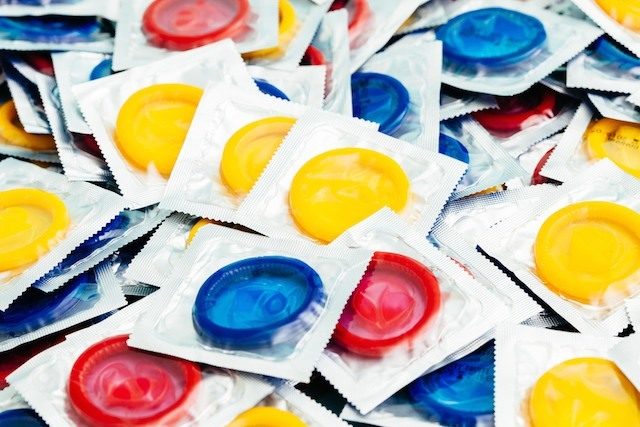SUMMARY
This is AI generated summarization, which may have errors. For context, always refer to the full article.

MANILA, Philippines — Got condoms?
Apparently, many Filipinos do not.
New HIV cases in the Philippines have grown by as much as 1,038% in as little time as 6 years, the Department of Health (DOH) reported in June 2015. At present, 21 Filipinos are reported to be infected with HIV daily.
Yet condom use among Filipinos has only increased by a mere 2% in two years.
|
Condom use in the PH |
|
| 2011 | 2013 |
| 35% | 37% |
Low condom use continues despite the many efforts of advocates to raise awareness on HIV/AIDS and the scientific studies proving the role of condoms in HIV prevention.
“Condoms, when used correctly and consistently, are highly effective in preventing HIV and other sexually transmitted infections,” the World Health Organization (WHO) stressed.
As of 2013, however, over 13% of Filipinos were unaware that “using condoms reduces the risk of HIV.” Although HIV awareness is generally quite high, many other Filipinos remain in the dark, the DOH found.
For example, over 40% of Filipinos still believe in the following myths:
- You can get HIV from toilet bowls
- You can get HIV from sharing food
- You can get HIV from mosquitos
Some Filipinos are also unaware that HIV can be prevented, that “healthy-looking persons” can have HIV, that having only “one faithful uninfected partner” reduces risk of HIV, and that sharing needles can increase one’s risk.
Meanwhile, others think that HIV/AIDS can only be acquired by gay men, dismissing the different ways on how it can be transmitted. This misconception roots back to the 1980s when AIDS was still labeled as “gay cancer.”
Such misinformation helps in the spread not only of the disease, but also of stigma.
To eliminate discrimination, Teresita Bagasao of UNAIDS Philippines advised health centers to make HIV/AIDS services lesbian, gay, bisexual, transgender (LGBT) friendly.
“HIV is our problem,” said Ina Pangan, Assistant HIV Surveillance Officer of the DOH Epidemiology Bureau. “Providing correct information and linking the key affected population to the HIV services we offer is our responsibility,” she continued.
The cities with the highest reported HIV cases include Quezon City, Manila, Davao, Makati, Pasig, Mandaluyong, Caloocan, Cebu, Pasay, and Paranaque.
Why no condom
The most cited reason for not using condoms, the DOH found, is that supplies are simply “not available.” Meanwhile, other Filipinos say they “don’t like condoms” or think that condoms are “not necessary.”
| Reasons for not using condoms | Percentage among Filipinos |
| (Source: DOH) | |
| Says condoms are unavailable | 37.82% |
| Doesn’t like condoms | 26.39% |
| Says condoms are unnecessary | 20.15% |
| Their partner objected | 8.07% |
| Forgot to use condom | 2.92% |
| Don’t know how to use condom | 1.7% |
| Says condoms are expensive | 1.18% |
To influence condom use, the DOH advises communities to make condoms more available, and for healthcare workers to make HIV/AIDS education more “understandable and personal,” including instructions on how to use condoms consistently.
Aside from learning about reproductive health and safe sex, the DOH also encourages individuals to get tested. Some Filipinos, however, have no idea that there are health centers and non-governmental organizations (NGOs) offering free condoms, HIV testing, counselling and treatment.
Some may also delay testing due to shame.
From 2011 to 2013, HIV testing increased but remained low, the DOH revelead. The percentage of Filipinos who never got tested remain virtually unchanged at 82.81%.
Prevalent among youth
As of May 2015, 28% of all cases were among the youth aged 15 to 24 years old. Most of them are males.
In the past decade, HIV cases in the Philippines have been increasing at the fastest rate among the young. They also have the least knowledge and access to HIV testing. (READ: What you need to know about children with HIV/AIDS)
“Even before their first sexual encounter, they should already know about condoms and how to use it,” Pangan suggested.
Meanwhile, the percentage of Filipinos with “comprehensive knowledge” of HIV/AIDS is still low though increasing with education, the 2013 Young Adult Fertility and Fertility Study (YAFFS) found.
| Percentage of Filipinos with comprehensive HIV/AIDS knowledge depending on educational attainment |
|
| College | 25.7% |
| High school/Vocational school | 19.6% |
| High school undergrad | 12.7% |
| Elementary | 8.4% |
“We are providing HIV testing,” Pangan stressed, “But people should know about this. Maybe there’s a lack of advertising or marketing.”
Half of Filipinos get their HIV information from the television, the DOH found. This is followed by inputs from friends and family – who may or may not be reliable sources.
Other major information sources include the Internet, peer educators, health centers, and NGOs.
According to the WHO, the Philippines has the world’s fastest growing HIV epidemic. Advocates, however, say the battle against HIV/AIDS is not impossible. Information, they say, remains the greatest weapon. – Rappler.com
For more information on HIV/AIDS, you may contact the DOH National HIV and STI Surveillance and Strategic Information Unit at HIVepicenter@gmail.com, (02) 495-0513, and (02) 651-7800 loc 2952.
Condoms image from Shutterstock
Add a comment
How does this make you feel?





There are no comments yet. Add your comment to start the conversation.